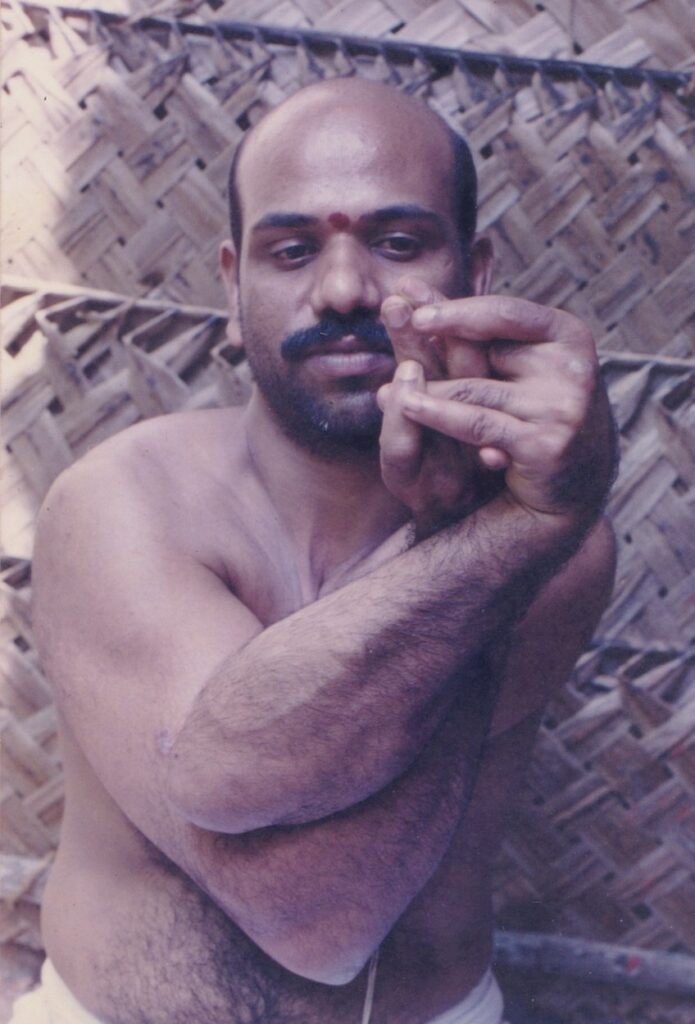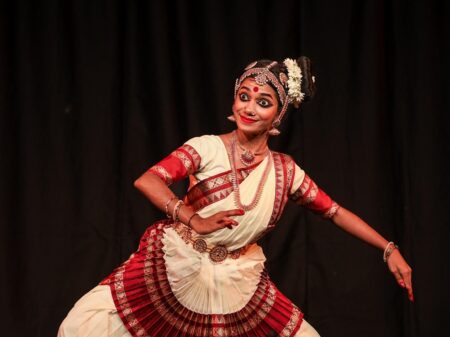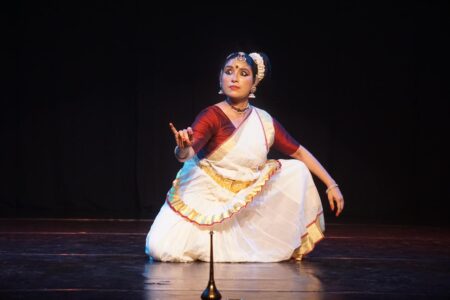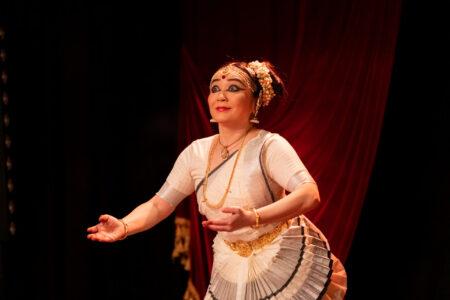No matter how much can be said about mudras, it is not enough. This article will give you a rough idea of the significance of mudras.
Hand gestures or Mudras are used by people world over from time immemorial for communicating. The term ‘Mudra’ has several connotations. Mudra-s are often used to as part of a sign language to communicate a meaning, transmit a message or as a symbolic expression of emotions. It can also be used to bring into visual an invisible object.
In the Indian classical dance context, ‘Mudra’ and ‘Hasta’ are interchangeable although they could mean different things contextually. In Sanskrit language the terms ‘Sanketam’ (Symbol)’ ‘Ingitam’ (intuition), ‘Angavikshepam’ (Gesture), ‘Soojana ’(Hint), Acting, and Mudra, all are related to Mudra or ‘Hasta’.
Another word ‘Kai’ is used in ancient Tamil literary works like ‘Panchamrab’ and Chilappathikaram ‘Kai’ instead of Mudra. For example, it is explained in the chapter ‘Arangettam’ that the dancer Madhavi used different Kai-s like Pindi (single hand/not joined/ ottakkai), Pinayal (joined hand/ samyuta hasta/ erattakkai), Ezhirkai( Shobhakkai or Nrithyakkai) and Thozhirkkai(communicative hand/ Abhinayakkai) in her debut performance. Other names like kaimudra, Kai, Hastam, Hastamudra, Kaikattu, and Nerkkaikattu are used in several dance and drama forms.
The early use of Mudra-s are linked with the system of Vedic chanting in which different hand gestures and head movements are used while chanting. ‘Mudras’ are a very ancient system that was used while reciting the ‘Vedas’. In Kerala, special ‘Swaras’ were used while reciting Vedas. Swara-s are given more importance in the veda recital. The system depends on the finger position marking. They are called Udatha, Anudatha, Swarita, and Prachya.
- Udatha: the middle lines of the index finger
- Anudatha : the first line of the index finger
- Swarita : the middle line of the ring finger
- Prachya : the last line of the middle finger
In order to avoid errors while reciting the ‘Vedas’, these Mudras are used with the correct signs. These are called the ‘Veda Mudras’.
Mudra in Tantra
Mudras are given prominent place in Tantric worship. These are given in the Tantra Sastras and Agama Sastras. These Mudras are used in worship and prayer. In ‘Kalikapuranam’ it is said that chanting, offering, yoga, meditation and Asana should be done along with Mudras in order to be effective. Certain Mudras are used to show the ‘Panchabhutas’ (the five elements).

Mudras used in religious worship belonged to three classes namely, the Vaishnava mudras, the Shaiva Mudras, and the Shakteya Mudras. Mudra-s are used to initiate a person into the Vaishnava tradition. In the Shaiva tradition the disciple is initiated sitting in the Trisulabja Padmam and the Asana is shown. It is said that when the disciple sees the mudras after the offerings, he could attain a spiritual state. In the Saktheya tradition Mudras are integral part of all types of worship in these traditions. For example, in the Manasa puja, pertaining to the puja of the mind, gestures corresponding to flowers and water are held at different parts of the body to signify the sky (gesture held close to the ear), air (nose), fire (eyes), water (stomach) and the earth (little finger).
In Tantras, Mudras are important while practicing meditation. Meditation is done by holding certain Mudras. Different gestures are used for different states of mind. It is believed that each Mudra enables the practitioner to attain a particular state of mind. This emerges from the belief that one can communicate with God through body gestures. Devotees say that they communicate with God through Mudras and attain a state of happiness. That is why it is said ‘Mudam Trayati Mudra’, meaning that which gives Mudam (Happiness) is Mudra.
Mudras in dance
Hand gestures are used in different ways in different styles of Indian classical dance. Mudras are held in different positions; towards the front, side, up and down of the body in these different forms. Enacting with the face is part of most of these forms. Bharata divides acting with gestures into ‘Shakha’,and ‘Ankura nritha .
Mudras of Shakha and Ankura
Shakha: Shakha refers to the literal meaning of a Mudra It is often referred to in Malayalam as ‘Nerkai kattuka’.
Ankura: Ankura refers to the use of Mudras beyond their literal meaning and to bring out the various interpretations while acting – the characteristic meaning of the particular line of the stanza intended or the meaning that it contains ( which could be brought out explicitly/ or like the capacity to act in the right way at the right time while performing on the stage) is called Ankura.
This kind of hand gesture is called ‘Vinyasa kaikattal’ in Mohiniyattam. Connotations of words, and sentences, sometimes the grammatical implications could also be acted out using hand gestures.
In ‘Sancharibhava’( cross emotions), take for instance the word ‘sundari’ (beauty)- the ‘Nerkai’ for woman of beauty could be shown first. Then, a woman with long, wide eyes like the petals of a lotus/ a woman with bow like eyebrows / a woman who shines with smile- all these could be acted out impressing upon the different dimensions of beauty as in the long standing traditions of Mohiniyattam.
Mohiniyattam uses both Natyadharmi and Lokadharmi aspects of acting and uses a large collection of Mudra-s these days. Often, the lyrical content of the poetry is limited to eight or 10 lines, but the detailed enactment and interpretation of that through gestures, acting and dance forms the main content of a performance. Improvisation of manodharmam of the dancers has a critical role in making these performances innovative and appealing.
In Sangam literature, the earliest literary work of South India, references to such acting is given. It is called ‘Ulvariyadal’. These references are given in connection with the dance of the ‘Viralis’- the dancers and actresses of the Chera Kingdom.
Balaramabharatam
This treatise on the ‘Science of Dance’ was written by Karthikathirunnal Balaramavarma Maharaja, who ruled over Thiruvithamkur between 1758- 1798 AD. In this treatise 40 un-joined hands and 27 joined hands and their applications are dealt with. 10 un-joined hands in the Balaramabharatam are not much different from the Mudras of ‘Hasta lakshna Dipika’, and four of them are different only in their names.
Assisted by Sreekanth Janardhanan
Photo Courtesy: Natanakairali Archives




